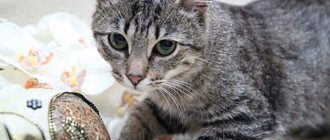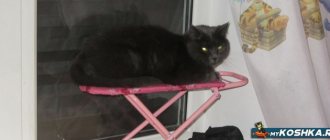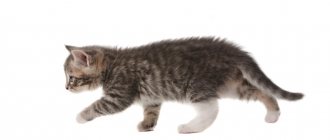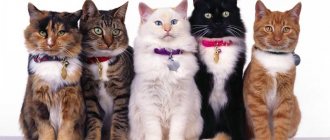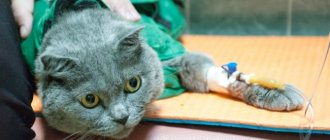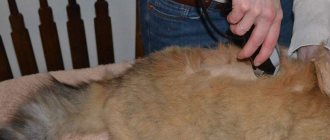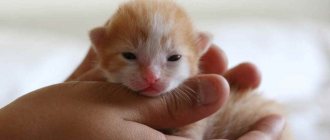The animal's postures and gestures, such as the tongue of a cat's tail, are in most cases well understood by hobbyists. Those owners who have just started communicating should learn what this or that movement means. A cat expresses its emotions in ways accessible to it: with its head, ears, paws, tail, meowing, tongue, characteristic sounds, a combination of gestures and behavior. Sometimes special attention is required so as not to miss a signal about the disease.
Facial expressions of cats
Cats also have rich facial expressions. In addition to the eyes and mouth familiar to humans, cats show their mood with the help of their ears and whiskers.
- Whiskers drooping down indicate cat sadness or illness;
- Round eyes and large pupils - plays, peers into the darkness or is afraid;
- A cat squinting demonstrates calmness;
- If a cat is looking straight ahead with wide eyes, she is very interested;
- A cat staring at you for a long time challenges you;
- He looks at you for a long time, and then slowly closes his eyes - this is how the cat “kisses” you and expresses devotion;
- Ears “on top of the head” show a playful mood;
- If a cat twitches its ears, it is nervous;
- Ears pressed to the head and laid back indicate that the cat is ready to attack;
- The ears spread out to the sides demonstrate feline curiosity;
- A cat quickly licking its nose and lips is confused;
- A quick lick of the front paw shows indecisiveness.
How to understand a cat's language by looking at its tail
In the course of research conducted by scientists from different countries, it became known that cats are capable of making over 60 different sounds. Thus, cats can vibrate in a variety of ways and also express their emotional state through body language.
In addition, the tail of cats is an indicator of mood. A sharply raised tail, pointing straight upward, means great enthusiasm, greeting and expression of joy. Such a signal can be intended not only for the owner who has returned from work, but also for his relatives whom the cat has met on the street. The greeting involves not only the tail, but also the bend of the body and a soft purr.
The following states of a cat can be determined by the tail:
A drooping tail means the cat feels frightened or slightly displeased. In such cases, it is better to leave the animal alone.
Twitching of the tail or sharp swings indicate a degree of nervousness. The cat wants to be alone and it’s best not to disturb it. In this case, the animal does not intend to enter into a discussion with its owner.
Twitching the tip of the tail is a manifestation of strong concern. The animal understands human speech and may show dissatisfaction about this if it hears unflattering reviews about itself.
The raised hair on the tail is a sign of intense rage and undisguised anger. The cat is preparing to attack.
A tucked tail between the hind legs is a feeling of fear.
Sleeping curled up in a ring
This is also one of the most common poses among domestic cats. This position is convenient as it helps maintain heat in the body and at the same time protect the most sensitive areas. If your cat sleeps curled up, she feels safe and completely relaxed. But be careful! Sometimes cats adopt this position when they feel pain due to certain health problems. Pay attention to your pet's behavior so you don't miss any warning signs.
How do cats talk to people?
Anyone can learn the language of cats. To do this, you need to study the meaning of gestures, facial expressions and sounds made by the animal. For translation from cat language to human, such nuances as movements of the tail, limbs, ears, postures taken by the four-legged pet, and the expression of its face are important. By the tone of the meow, you can also determine what the pet is trying to convey to its beloved owner.
Sign language: what does the tail, paws, ears, posture mean?
There is a cat language dictionary that will help you “read” your pet’s gestures. Most members of the cat family show emotions in the same way. They do this through their tail, paws, ears and posture. Knowing the meaning of the movement and position of these organs will make interaction with the four-legged inhabitant of the house more effective. Information about the sign language of these animals:
| Gestures | Values | |
| Tail | Waving the tip | Curiosity, irritation, sadness |
| Swinging up and down | Strong excitement | |
| Actively beats its tail on the floor | Anger, readiness to attack | |
| Rotational movements of the tip | Readiness for defense | |
| Raised high | Friendliness, joy | |
| Tucked between hind legs | Fright | |
| Down and disheveled | Danger | |
| Paws | Fumbling, marking time | Happiness, pleasure |
| Pull | Self confidence | |
| Flexion | timidity | |
| Ears | They are moving | Alertness |
| Pressed and pulled back | Playfulness | |
| Pressed and lowered on the sides | Aggression, fear | |
| Shaking nervously | Uncertainty, irritation | |
| Pose | Body pressed to the floor | Ready to attack |
| Rolling on the floor | Showing attractiveness | |
| Arching your back | Irritation, readiness to defend | |
| Sitting pose with folded paws | Relaxation | |
| Lying on your side |
Facial language: smile or grin?
The facial expressions of these animals are varied and very expressive. Unlike vocal signals, it is innate and can say a lot about the pet’s mood. Newborn kittens instinctively recognize the meaning of the expressions in the eyes, smiles and grins of their relatives. People need a special dictionary for this. What does a cat’s smile or grin mean:
- grin - study of smells;
- closed or slightly open mouth - calm;
- a closed or slightly open mouth with the tip of the tongue protruding (sometimes bitten) - bliss;
- lips raised in a grin, bare teeth - a threat, readiness to attack;
- yawning – complete relaxation;
- rapid licking of lips and nose - anxiety, confusion.
Vaska, voice!
A cat can express its emotions not only with its tail, ears, eyes and posture. She is also able to “say” a lot with the sounds she makes, namely the height of their register, length, and timbre color. Learning the basics of cat vocal communication will help you better understand your pet.
Dictionary of cat sounds:
- quiet and soft - a great mood;
- loud uterine or strangled sounds - dissatisfaction, resentment;
- piercing - pain, request for help;
- very loud, sharp - readiness to attack, fear, anger.
Typically, cats express pain, aggression and fear with lower sounds, while positive emotions, on the contrary, with higher sounds. Detailed interpretation of sounds made by kittens or adult cats:
- purring - pleasure, calmness, the highest degree of pleasure;
- rumbling - dissatisfaction, warning;
- hissing - readiness to attack, irritation;
- howling - anger;
- short cry - fear;
- meowing - a greeting, a request (cats meow when they want to eat).
Gestures of cats
A more eloquent way of expressing thoughts in cats is through gestures. Unlike sounds, kittens know behavioral movements from birth. If you watch your kitten, you will notice that he uses gestures like an adult.
Popular cat body movements:
If suddenly a cat on long legs rushes past you, head pressed into its shoulders, you can begin to figure out its crime, it knows that it has done something wrong; The cat knocks its tail - it is not in the mood, it is better not to disturb it; When a cat kneads you with its paws, purring, it is in bliss and remembers its childhood: this is what kittens do when they suck milk; A sharp raising of a paw with claws is a threat to hit you with it; An attempt to hug you with its paws or stroking them indicates the pet’s love; Pipe tail - greeting, good mood; Arching the back is a threat, intimidation; Rolling on the floor and showing off your belly shows your trust and friendliness; If a cat rubs its head against you, it is greeting you and wants you to pet it; The cat raised her relaxed paw - she was interested in something; The cat has its paws pressed together, which means it is relaxed or waiting for something; Scratching loudly with its claws - trying to attract attention; If a cat looks around and licks itself, it is showing its calmness, which may be feigned.
Some cat gestures resemble human ones: you can easily draw an analogy.
Do you understand what your cat is saying?
Theory ALL ARTICLES 4846
Does your cat understand you? A new project by Swedish scientists is dedicated to studying communication between humans and cats.
Many animal species, from wolves to dolphins, are thought to have an "accent" depending on where they live. Now scientists from the University of Lind (Lind, Sweden) intend to find out whether the cat language has local “dialects” and how the human voice influences the characteristics of cats’ meowing.
Here's what the project leader, phonetics professor Susann Schötz, says: “Cats seem to be able to consciously change the intonation and melody of their meow depending on what message they want to convey, how urgent that message is and how emotionally charged it is. We want to find out how cats are affected by the language, dialect and intonation of the people who communicate with them. Because there is a suspicion that the different “talk” of people from different regions influences the “talk” of cats.”
Photo: Susann Schötz and her experimental cat
“In our project we will use phonetic analysis to compare the “language” of cats from two different provinces of Sweden: central (Stockholm) and southern (Lind). Comparing the “melodies” of cat vocalizations will help to find out whether cats, like people, speak different dialects,” continues Susann Schötz. “In the next few years, we will be able to understand what cats are trying to tell us humans, and how they would like us to talk to them.”
The official name of the project: “Melody in human-cat communications.” It involves three researchers from two universities, Linde and Linköping. For short, scientists call it “Meowsic.” The study will take five years until 2021.
To understand the peculiarities of communication between humans and cats, a group of scientists will focus, on the one hand, on studying the intonation, voice and style of speech of people addressing cats, and on the other hand, on the melody of meowing cats addressing people.
Today this may seem strange, but in the future the results of such a study will help people build normal communication with cats at home, in veterinary clinics, nurseries and shelters.
In this video, Susann Schötz gives an interview to the official channel of Linden University:
As a result of cat domestication, which began about 10,000 years ago, cats learned to communicate with humans using visual and auditory signals. Some cat breeds—Siamese, Burmese—seem to be more “talkative” than others. Perhaps a cat’s “conversational” skills depend, among other things, on the breed.
Feral and stray cats usually stop meowing as adults, when they no longer need to interact with their mother cat. Domestic cats use meowing to attract people's attention and communicate with them. However, many aspects of the vocal repertoire of cats are not completely understood by everyone.
“We know that cats can change the melody of the sounds they make over a fairly wide range, but we don’t know how to interpret these changes,” says Dr. Schötz. “We will record the sounds made by thirty to fifty cats in different situations: when they want to get somewhere, when they are content, friendly, happy, hungry, irritated or angry. And then we will look for differences in phonetic structures.”
Even before the start of the project, scientists, while testing equipment, recorded several samples of cat “melodies.” In one of them, they noticed that the pitch of a cat's meow slowly rises when the cat asks for food, and vice versa, it decreases when the cat feels uncomfortable at a veterinarian's appointment.
Another goal of the study is to determine whether there are differences in cats' reactions to various aspects of human speech: voice timbre, communication style and intonation. When addressing a cat, people usually raise the pitch of their voice, as when communicating with children. And Dr. Schötz wants to find out what the cats themselves prefer - lisping or communication as equals, as with adults.
“We still have so much to learn about how cats perceive human speech!” — Susann Schötz anticipates. In the meantime, the learned lady has opened an account on YouTube, where she posts videos with various examples of a cat’s “meow”:
In the video: Susann Schötz's cats beg for shrimp.
How to gain a cat's trust?
The authors of the scientific work became interested in whether a person can earn the trust of an animal by smiling “like a cat”? To find out, they conducted a two-part scientific experiment. The action took place inside the apartments where cats lived
It was important that the animals felt as comfortable as possible and did not experience stress, expecting danger
Cats feel best at home - they feel stressed in an unfamiliar place
The first part of the experiment involved 21 cats ranging in age from several months to 16 years. The owners sat in front of their pets at a distance of about one meter. Then, under the supervision of a psychologist and cameras, they squinted their eyes and blinked slowly. As expected, the cats responded by blinking at their owners in the same way. The authors of the scientific work perceived this as a success - yes, owners can get closer to their pets by smiling at them in a special way.
Smile and the cat will give you a high five!
In the second part of the experiment, scientists tested whether cats could trust strangers. The study involved 24 cats aged from one year to 17 years. This time, scientists sat in front of them, whom the cats saw for the first time. Some researchers blinked slowly, while others simply sat there, looking away. When they extended their hands to the animals, the cats reciprocated only the researchers who “smiled” at them. Based on this, scientists have concluded that almost anyone can establish a connection with cats.
Sleeping on your side
This is one of the most comfortable positions a cat can assume. She feels completely safe, so she has no need to protect her vital organs. The cat is probably sleeping deeply and not worried about anything at all. Purrs who sleep in this position usually have a strong emotional connection with their owners and are not afraid to show trust.
When training your cat, teach yourself
Since cats are interested in learning new methods of communication with the owner, your initiative will help establish close interpersonal contact and achieve obedience from the pet. The more actively you communicate with your cat, the faster it will learn to understand you.
To show your cat that you are friendly and satisfied, use a raised tone of voice. To express disappointment, resentment or dissatisfaction, speak quietly and clearly pronounce hissing sounds.
Verbal communication
When communicating with your cat, try to use the same words and say them slowly. Periodic repetition will allow you to consolidate a clear associative connection.
Experiments have shown that at the age of up to 6 months, cats can easily remember from 30 to 70 voice messages from the owner
It is important to understand that this is not about commands or orders, but about explaining your actions
For example, by repeating the words “sleep” every time, you can train your cat not to disturb you at night, to climb into your bed, or to ask for food in advance.
When communicating with a cat, always be consistent in your intentions.
If you need to punish your pet, do not shout or use the word “no”. The true relationship has not yet been clarified, but zoologists have proven that cats are embarrassed when they hear the word “no”, but normally perceive the words “later”, “later”, “not now” and so on.
Non-verbal communication
Cats perceive non-verbal communication signals instinctively and without difficulty. You can test it on your own pet: slow blinking expresses affection and provokes the cat into close communication.
Watching your pet hesitate in its decision to jump on your bed, be silent and lightly tap your palm next to you - the pet will perceive the gesture as an invitation.
If your cat does this, sound the alarm!
1:502 1:507
Cats often take very funny poses, photos of which owners like to share with each other, without even suspecting that they give cause for concern, and not for a smile.
1:825 1:830
For example, on the Internet you can find many photographs of cats sitting with their faces to the wall and resting their foreheads on it. The owners accompany them with humorous captions like “I’m offended” or “I can’t see you,” etc., without even suspecting that such a pose indicates a serious disorder in the cat’s health!
1:1386 1:1393
2:1899 2:6
It turns out that in this position the animals are trying to somehow relieve the headache, which is most often caused by injury accompanied by a concussion. This is a very insidious condition, because sometimes the owner does not even know about what happened. He jumped unsuccessfully, did not fit into the turn of the corridor, was hit on the head by an object thrown by another pet - all this can happen in the absence of a person, and a cat naturally cannot complain of a headache.
2:841 2:848
3:1354 3:1361
- rapid twitching and movements of the eyeballs,
- dilated pupils that do not contract in bright light,
- impaired coordination of movements,
- loss of orientation,
- convulsions,
- rapid pulse,
- heavy breathing, etc.
3:1892
The set of symptoms depends on the severity of the injury and the location where it occurred.
3:136 3:143
4:649 4:656
It should be remembered that even a mild concussion causes quite extensive damage.
4:832
Brain tissue suffers not only at the site of impact, but also on the opposite side, because the brain, not fixed, but floating in the brain fluid inside the skull, is sharply deflected by inertia and hits the other wall of the skull.
4:1269 4:1276
Only an experienced veterinarian can alleviate the animal's condition . We say “experienced” because diagnosing a concussion is very difficult, and there are no specific methods for determining it. In human medicine, a detailed description by the patient of what happened to him and his condition helps; in veterinary medicine, one has to rely on the consciousness of the owner, who will carefully observe the cat and be able to describe all the symptoms.
4:2114 4:6
5:512 5:519
Having made a diagnosis, doctors usually prescribe vascular agents to prevent edema, as well as painkillers, antiemetics, sedatives, and, if necessary, medications to support the functioning of the lungs and heart.
5:944 5:951
The owner’s task is to provide the cat with complete rest , which is a prerequisite for recovery from head injuries - without it, even the most competent drug treatment will not be effective. So for a while you will have to forget about receiving guests, loud music, watching football matches on TV and general cleaning. It is advisable to ensure that other pets do not bother your sick friend.
5:1732 5:6
6:512 6:519
In conclusion, we will say that in addition to a concussion, the cause of headaches and dizziness that causes a cat to rest its head against the wall can be acute toxic conditions, that is, poisoning, diseases of the nervous system, tumors of the brain or spinal cord, and some other conditions.
6:1066 6:1073
7:1579 7:6
So in any case, this is a very serious symptom that requires immediate attention to a veterinarian..
7:214 7:221 7:226
How cats talk to us
Cats and cats communicate with each other using body movements and smells, rarely using sounds. When we are around people, they notice that we respond better to their voice than to body language.
Cats communicate with each other using body language and smells.
Therefore, animals change their communication style to exploit human strengths and weaknesses.
Types and meaning of cat talk
To express its emotions with its voice, a pet always pronounces exactly those sounds that are suitable for a given situation. They differ in strength and timbre (high or low). Any trouble is expressed by low sounds, and peace and pleasure are expressed by high sounds.
Meowing in the form of a long “meow” is a greeting to the owner who has returned home or a request, and sometimes a complaint. The short “me” means confusion or question
The goal of any “meow” is to attract the attention of others. If the owner does not respond to the first polite “meow”, the cat will ask more demandingly and loudly in order to achieve results.
Vowel sounds in different keys are a cat’s request:
- “I want to go outside”;
- “it’s time to eat”;
- "I'm upset";
- "I'm in pain."
Many owners have paid attention to “silent meowing,” when a cat, looking at a person, opens its mouth, but there is no sound. In fact, it exists, but in the ultrasonic range, which only animals can hear
But a person more often reacts to such a quiet “meow”, and the cat notices this and uses it with might and main.
Purring (special cooing sounds) shows the calm state of the cat, without aggression. He is happy with everything. Mother cats purr for kittens: everything is fine, there is no danger. This is how a pet shows its affection for its owner. He is happy when petted, purrs and squints his eyes. If he follows you around, tries to climb onto your lap, brings you a toy or food - this is also a sign of his love. When he rubs his head against your legs or “butts” his forehead, massages with his paws, licks your hand and sits next to you if you are sick - do not doubt that you are more important to him than anything in the world.
By purring, the cat shows that he is happy and loves you.
If dissatisfied, the cat purrs in low tones, warning that you are interfering in its affairs. Hisses when scared, but does not dare to attack. If he snorts and moves forward when meeting an enemy, he is ready for a fight. With a loud howl, he tries to break the enemy’s fighting spirit so that he retreats first.
Cat body language and body language
In addition to sounds, cats communicate with each other and with people using gestures and different positions of their bodies. The main tools for expressing emotions are the tail, eyes and ears.
Body position indicates mood, and maximum anger and intimidation before a fight can be accompanied by a howl or growl
"Tail" emotions
Tail movements show a cat's mood:
- wagging the tip of the tail is a sign of curiosity or irritation, sometimes sadness;
- if the tail whips up and down quickly, there is strong excitement;
- the tip of the tail rotates - it will defend itself;
- a triumphantly raised tail signifies friendliness and joy;
- the tail is tucked between the hind legs when frightened;
- the tail is lowered and ruffled in case of danger.
Eyes and ears
With wide open eyes, the cat shows curiosity, looks straight ahead - ready for battle, and his pupils sharply constrict if he is angry. Half-closed eyes indicate peaceful relaxation.
When the cat is completely relaxed, he stretches and looks at the world with half-closed eyes.
You can tell by the position of the ears when the cat is scared and trying to threaten. In this case, they are pulled back and pressed against the head.
If during a game the cat is discouraged by what he sees and cannot find an explanation, this can be seen from the expression of his face
If the ears twitch nervously, this means irritation and readiness to fight back. Vertical - study.
Curiosity is indicated by wide eyes and erect ears.
If a cat is dozing with his eyes closed and his ears moving in different directions, this is a skillful pretense; in fact, he is listening carefully to your conversation.
Emotional mustache
When a cat is happy and calm, his whiskers cheerfully stick out in all directions. They twitch while tracking prey. If the cat is interested in something, they are directed forward. Tranquility is reflected by the mustache flowing freely on the sides of the head.
Professional opinion
A protruding tongue may indicate a relaxed cat.
No matter how touching an animal that shows its tongue may look, you should never forget about the danger. Scientists have repeatedly stated that today we strive to first capture everything unusual or funny that we see, and only then we begin to think about what it could mean.
- First of all, a protruding tongue in a relaxed state means complete peace.
- Secondly, this may indicate problems with heat exchange, and here it is necessary not to film what is happening on camera, but to take care of saving the pet from the heat.
- Thirdly, and this is perhaps the most significant, any changes in the animal’s behavior, along with the unexpectedly emerging habit of sticking out its tongue, can indicate dangerous and contagious diseases. For example, an acute viral infection - rabies - is characterized precisely by the fact that the cat’s behavior becomes aggressive, it can run with its tongue hanging out like a dog, and there is profuse salivation. At this time, the animal poses a threat to everyone, because they have not learned how to treat this disease.
Californian researchers believe that in adulthood, a cat's tongue may not fit in its mouth due to diseases of the teeth, gums and oral cavity.
Veterinarians also agree that when you see a protruding tongue, you should not be moved and tell everyone what an interesting cat lives in the house, but first show it to specialists in order to rule out a number of diseases dangerous to the animal and people. The inspection will take a few minutes, and then, if everything is in order, you can continue to be touched.
Paws
Paws play a big role in the communication between a cat and its owner. If it “stomps” and shifts from paw to paw, while purring and spinning, then this is an expression of love and goodwill towards a person. This is the highest manifestation of tenderness and trust.
Also, by lightly touching their paws, cats can simply attract a person's attention. For example, for him to stroke.
But extended claws and sudden movements of the paws indicate that the cat is unhappy with something and is angry. As a rule, this gesture is combined with corresponding facial expressions and body posture: ears are flattened, fur is raised.
Why do cats have rough tongues?
If you are the happy owner of a cat, then you have probably at least once, by accident or for some reason, literally experienced first-hand what kind of tongue it has. And not everyone likes this feeling. Why does a cat need such a rough tongue?
First, let's look at the anatomy. On the surface of a cat's tongue there are many capillary papillae, which are covered with keratin and curved towards the throat. The result is these kind of hooks that have many functions, but at the same time sometimes complicate life.
One of the purposes of the tongue is as a comb. And the keratinized papillae act as teeth. As you know, the vast majority of cats are inveterate cleaners. And with the help of their rough tongue, they remove parasites and dirt from the fur, and “comb out” dead hairs.
By the way, dogs also lick themselves, but their tongue is smooth. Why? The fact is that dogs do not use their tongue as a comb for fur that thoroughly. In nature, many individuals prefer to clean themselves by swimming in ponds. Most cats do not have a special love for water procedures, so they have adapted to do without them.
However, tidying up the fur with the help of such a “tool” also poses dangers for the domestic relatives of tigers and lions. Due to the fact that the tongue hooks are bent back, some of the hair remains on them, and the animal has to swallow it. If events develop favorably, the cat will soon get rid of them naturally. But if the hair is too long and there is a lot of it, then the pet may develop an obstruction of the stomach or intestines. Then you will have to give special medications or take your pet to the veterinarian.
The second equally important function of a rough tongue is to help with nutrition. Cats, like sandpaper, can cleanly separate meat from bones and get tasty morsels in hard-to-reach places. This is especially true for wild felines.
Finally, in extreme heat, just like dogs, the tongue helps cats regulate their body temperature by cooling the body.
The inconvenience of this structure of this organ occurs when pets, for example, while playing with something, cannot get rid of the object, and they have to swallow it (as in the situation with cleaning fur). This often happens with threads and New Year's rain. In addition, some objects (for example, small seeds) can get stuck between the scales of the tongue, injure it, which will cause inflammation.
And if it is believed that a dog can heal a wound by licking it, then a cat’s rough tongue will only cause irritation. However, if your pet decided to wash you and there are no health objections (for example, allergies or skin damage), then perhaps it’s worth being patient with this “massage” for a while? After all, cats do this much less often than dogs, and such a manifestation of care and attention means a lot in their world.
Photo source: https://i.ytimg.com/vi/ayRkSYR5JW4/maxresdefault.jpg
Did we forget to mention something? Do you have anything to add or complement? Write to us!
The author's opinion may not coincide with the editorial position!
Sleeping with half-closed eyes
No matter how cute and domesticated your cat may be, she is still a predator at heart. Cats remain alert to everything that happens around them, so they have to fight the urge to doze off and settle into a more comfortable position. This way they stay alert. If your cat sleeps with one eye open, it means that one part of her brain is asleep and the other is awake.
Tail
What does a cat’s tail “say”? How can you tell about a mustache's mood by looking behind its tail?
Wags its tail
Wagging the tail (i.e., the entire length of the tail moves slowly and smoothly from side to side) usually signals excitement, alertness and interest in the environment.
Swings its tail
Tail wagging (i.e. the tail moves quickly from side to side, an aggressive movement) means that the cat is agitated and irritated. Usually, when a cat does this, it takes an aggressive position. The hairs on her tail stand on end, causing it to become fluffy. In this case, it is better to leave the cat alone, otherwise you risk becoming a victim of its attack.
Twitches his tail
If a cat twitches the tip of its tail, it means that the cat is showing interest in something it sees. However, this gesture can also be the first sign of aggressive behavior, for example, if a strange cat has invaded the territory. In this case, following this gesture, the cat will begin to swing its tail and behave aggressively.
Tail shaking
This gesture is typical of cats marking their territory. Your cat may also quiver the tip of its tail when it rubs against your legs or when you scratch its back, especially near its tail. In this case, the shaking of the tail is a gesture of great affection towards you.
Tail up
If a cat holds its tail like a pistol while walking, this means that it is happy and confident. Other nonverbal cues (such as gait or gaze) will also reflect this behavior.
Tail partially tucked between legs
This gesture usually means that the cat is scared, unhappy, or feels threatened. Accompanying nonverbal gestures: ears flattened, head lowered, body pressed to the ground.
Sphinx pose
The position of the sphinx (the cat lies on its stomach, with its paws tucked under itself and its head raised) means that the animal is quite happy with its surroundings and its place of stay, and enjoys the situation to the fullest. The cat is not going to run away, because it does not see any threat. Rather, she feels completely safe and happy. This position also helps your pet save energy.
Annoyed
Cats that are mildly stressed or trying to avoid something unpleasant for them squint, blink rapidly and/or look away. The body will be tense and possibly pressed to the floor. One paw can be raised slightly upward to cover its muzzle if necessary.
At the same time, you may notice that the cat yawns, licks the area around the mouth, often drinks water, and blinks. At the same time, the pupils may be dilated, ears perked up in different directions, and mustaches sticking out forward. The tail is either held tightly to the body or twitches and sways from side to side. All these methods help to strengthen environmental monitoring.
Sleeping on your back
The abdominal area is one of the most vulnerable parts of any cat's body. So, if your furry friend sleeps on the sofa with his belly up, with his paws scattered in different directions, he is telling you that he trusts you completely, for which you can be congratulated. This means that you deserve to be liked. This sleeping position is the most common among pets. But cats that live outside rarely experience such a strong sense of trust in the environment.
Do cats understand humans?
There are many opinions on this matter. Absolutely all cat owners believe that their pets understand their owners perfectly. But what does science say about this?
Scientists have different opinions on this matter, but one thing has been proven with certainty: a cat reacts not to words, but to the intonation with which they are pronounced.
This is clearly proven by the experience of Logan Forbes, a specialist in cat physiology and behavior. She said the phrase “We're going to the vet” before every doctor's visit with the same intonation. Gradually, the cat associated the phrase with an unpleasant procedure and began to run and hide every time it was repeated. But as soon as Logan uttered a phrase with a different intonation, the cat immediately stopped reacting to it.
Interesting fact: cats especially enjoy being scratched at the base of their tail.
This is believed to be due to the fact that cats have a very wide hearing range - from 20 to 70,000 hertz. They are able to detect microscopic changes in voice intonation. But not only this helps cats communicate with us.
It is believed that cats can read human thoughts
For example, research by Susanne Schölz, a Swedish phonetic scientist at Linköping University, confirmed that cats learn to communicate with humans in a special way. They connect events with intonation, gestures and actions of people, remembering them, and thus “create” an individual “language” in which they communicate with the owner. For example, if you open the refrigerator before each feeding of your pet, then she will very quickly remember this peculiar “ritual”. The cat is also able to connect its actions and their consequences with the reaction of the owner.
The most interesting thing is that for each person the cat has its own “language”. This can be proven by the experience of Irina, the owner of the cat George from the USA.
Cats are good at distinguishing voice intonations.
The woman was proud of her pet, as he was a real genius of the cat world - he followed many commands and understood his owner literally at a glance. But one day Irina took the cat with her to her friend Annette in Denmark. Irina told Annette about George’s unusual nature and, for clarity, suggested saying several commands that the cat had been trained to use. But, despite her excellent command of English, Annette could not get the slightest reaction from the cat.
Research from the University of Tokyo was also able to prove that cats are able to remember the voice of their owner. Scientists conducted the following experiment: a stranger and the owner addressed a cat in turn, but the animal could not see the speaker. Each time the cat reacted to the sound by turning its head in its direction. But only after the owner’s address did each cat’s pupils dilate, which indicated certain emotions.
When cats hear their owner's voice, their pupils dilate
